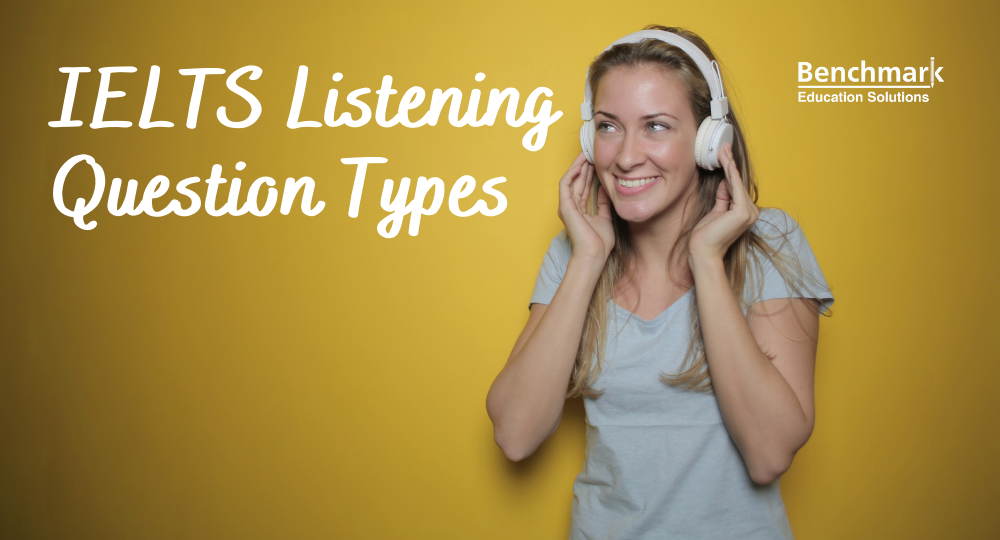IELTS Listening Question Types
- 1 Comments


The IELTS Listening test is the same for both IELTS Academic and IELTS General. First, we’ll discuss some general information about the test. Then, we’ll go through each question type and focus on the skills you will need to answer each one. We’ll also give you some helpful tips!
Table of Contents
General Information about IELTS Listening
If you are taking the paper based IELTS Listening test, you will hear 30 minutes of audio recordings. Write your answers on the question paper as you listen. When the recordings finish, you will be given 10 minutes to transfer your answers from the question paper to the IELTS listening answer sheet.
If you are taking the computer based IELTS listening test, you will put your answers directly into the computer during the 30 minutes of listening time. When the recordings are finished, you will get 30 seconds after each section to review your answers and check your spelling.
What Kind of Accents Will I Hear?
You will probably hear mostly British accents, but you may hear others as IELTS is an international Englis exam. You can spell your answers with either British spelling or American spelling, but you should be consistent and use one or the other – don’t mix them together.
What Kind of Recordings Will I Hear?
You’ll listen to four different recordings containing dialogues like these:
Section 1. Social setting (conversation between two people)
Section 2. Social setting (one person giving a speech or monologue)
Section 3. Academic setting (one person giving a speech or monologue)
Section 4. Academic setting (conversation between three or four people)
Section 1 is the easiest, and the questions become more difficult as you progress to section 4. You will answer a total of 40 questions while you listen.
It’s Important to Read the Instructions
Read the instructions for each IELTS listening question carefully! If your question contains a word limit, it may be different for each question. For example, if your instructions say, “No more than two words and/or a number,” your answer can contain one word, two words, one number, or one word and one number. Notice that “words” is plural, and “number” is singular. Contracted words such as “don’t” will not be tested, and hyphenated words such as “back-and-forth” count as one word. If you use more words and numbers than you are allowed, your answer will be incorrect.
Your answers must also be spelled correctly. However, don’t worry about spelling words correctly while the audio is playing. Use your review time to double-check the spelling of your answers.
IELTS Question Types
Here is some quick information about the different kinds of IELTS listening questions you can expect to see. Click on the link in each topic to go to an article with more information about that question type, and a sample question you can try.
1. Multiple Choice (Single Answer)
Answer a listening question by choosing the correct option from a list of possible answers. You will need to read the question carefully to decide if you should choose just one answer, or if the question is asking for all possible (multiple) answers. (Click here to learn more.)
Skills:
- Listening for keywords
- Listening for gist and overall meaning
- Listening for detail
- Understand synonyms
Helpful Tips
- The questions follow the order of the audio.
- You will have three answer options to choose from.
- The questions usually use synonyms of words found in the audio.
- Use the process of elimination to narrow down the correct answer.
- There is no negative marking so do choose at least one option even if you are unsure about the answer
2. Multiple choice (Multiple Answers)
Choose all of the correct answers to a question. (Click here to learn more.)
Skills:
- Listen for keywords
- Focus on supporting details instead of the main idea
Helpful Tips
- You will have a longer list of answer options from which to choose.
- Read the answer options before you listen to the audio.
- Remember the key words you found in each answer option and listen for them in the audio.
3. Matching
Match small segments of text (like examples or details) to the part of the text that contains the information. (Click here to learn more.)
Skills:
- Listening for details in the text
- Ability to follow a conversation between two people
- Recognize connections between relationships and facts
Helpful Tips
- Check for synonyms – the words in the questions do not necessarily appear in the audio.
- Read the questions first, noting keywords that you can listen for.
4. Labeling a Plan
Complete the labels on a building plan. (Click here to learn more.)
Skills:
- Understand a description of a place and relate it to a visual representation
- Follow language expressing directions
Helpful Tips
- You will have a list of answer options to choose from.
- Read the label choices first, then look at the building plan.
- There could be more labels than you will need, so you may not use all of the answers.
- Knowing in advance as the location of question numbers to label helps finding the answers and avoids gettling lost
5. Labelling a Map
Add labels to a map by listening to a description of a place. (Click here to learn more.)
Skills:
- Relate a verbal description to a visual representation
- Understand language involving directions, such as “go straight,” “turn left,” “opposite,” etc.
Helpful Tips
- You will choose your answers from options in a word bank.
- Make sure your answer makes sense grammatically. You can eliminate choices that don’t make grammatical sense.
- There are more labels than you will use, so you can’t use the process of elimination.
6. Labeling a Diagram
Add labels to a diagram (for example, a piece of equipment) as you listen to a description. (Click here to learn more.)
Skills:
- Listen for specific information
Helpful Tips
- You will have a word bank of labels to choose from.
- Make sure your answer makes sense grammatically. You can eliminate choices that don’t make grammatical sense.
- There are more labels than you will use, so you can’t use the process of elimination.
7. Form Completion
This the first of four kinds of questions where you need to fill in the gaps in a listening text. For form completion, you will add missing information to a form. The information will include factual details such as names, addresses, telephone numbers, etc. (Click here to learn more.)
Skills:
- Listen for specific information
Helpful Tips
- You might find the answers from listening to the text, or they may be in a list presented in the question paper.
- The gaps will be in the same order as the audio recording
- Keep to the word limit stated in the instructions.
- Use the EXACT WORDS you hear in the recording
- Focus on the main points which a listener would normally record in this kind of situation.
8. Note Completion
This is the second of four kinds of questions that require you to fill in the gaps in a listening text. For note completion, you will summarize information to show how different items relate to each other. (Click here to learn more.)
Skills:
- Listen for specific information
Helpful Tips
- You might find the answers from listening to the text, or they may be in a list presented in the question paper.
- The gaps will be in the same order as the audio recording
- Keep to the word limit stated in the instructions.
- Use the EXACT WORDS you hear in the recording
- Focus on the main points which a listener would normally record in this kind of situation.
9. Table Completion
This is the third of four kinds of questions that require you to fill in the gaps in a listening text. For table completion, you will summarize information in categories. For example: place, time, and price. (Click here to learn more.)
Skills:
- Listening for detail and specific information
Helpful Tips
- You might find the answers from listening to the text, or they may be in a list presented in the question paper.
- Check the progression of questions The questions will not necessarily go from left to right in the table.
- Keep to the word limit stated in the instructions.
- Use the EXACT WORDS you hear in the recording
- Focus on the main points which a listener would normally record in this kind of situation.
10. Flow Chart Completion
This is the fourth of four kinds of listening questions that require you to fill in the gaps in a listening text. For flow chart completion, you will fill in missing words from the different stages of the chart. (Click here to learn more.)
Skills:
- Listening for detail and specific information
Helpful Tips
- You might find the answers from listening to the text, or they may be in a list presented in the question paper.
- The gaps will be in the same order as the audio recording
- Keep to the word limit stated in the instructions.
- Use the EXACT WORDS you hear in the recording
- Focus on the main points which a listener would normally record in this kind of situation.
11. Sentence Completion
You will need to complete unfinished sentences using words from the audio text. Fill in the gap in each sentence using information you hear. (Click here to learn more.)
Skills:
- Identify key information in an audio recording
- Understand relationships between information; for example, cause and effect
Helpful Tips
- The information may come from all of the listening text, or from one part of it
- Keep to the word limit stated in the instructions.
- Use the EXACT WORDS you hear in the recording
12. Short Answer
You will read a question on your answer paper, then listen to an IELTS audio recording for information you will use to write your answer. (Click here to learn more.)
Skills:
- Listen for facts and specific information
Helpful Tips
- You may be asked to list two or three points from the audio recording.
- Keep to the word limit stated in the instructions.
- Identify the keywords in the question
We have covered the most useful skills and tips for the IELTS listening questions. Be sure to click on the links for more information about each question type. Keep in mind that practice is key, especially when it comes to listening for the overall meaning of a text.
Good luck preparing for your IELTS exam!










It is a great help for the beginners. Thanks for cascading your Proficiencies.